Evaluating the Barriers to Blockchain Adoption in the Energy Sector: A Multicriteria Approach Using the Analytical Hierarchy Process for Group Decision Making
Abstract
1. Introduction
- In Section 1, a general introduction about the current state of the energy sector, as well as a brief description of blockchain technology, are provided. The scope of the paper is also described.
- In Section 2, the methods used for the identification and evaluation of the use of the blockchain in the energy sector, consisting of a literature review, market analysis and the Analytical Hierarchy Process (AHP) for Group Decision Making (GDM), are presented, while the sources of material are also mentioned. The research design and methodological steps are also outlined.
- The results of the implementation of the methodological steps are displayed in Section 3.
- In Section 4, the results are analysed, discussed, and compared with relevant research studies.
- The conclusions are drawn in Section 5.
2. Materials and Methods
2.1. Sources of Materials and Description of the Methods Used
2.2. Research Design and Structure
3. Results
3.1. Review of Blockchain Applications in the Energy Sector
3.2. Market Analysis of Blockchain in Energy
3.2.1. PESTLE Analysis
3.2.2. SWOT Analysis and Identification of Barriers
3.3. Analytical Hierarchy Process
4. Discussion
5. Conclusions
Author Contributions
Funding
Data Availability Statement
Acknowledgments
Conflicts of Interest
Appendix A
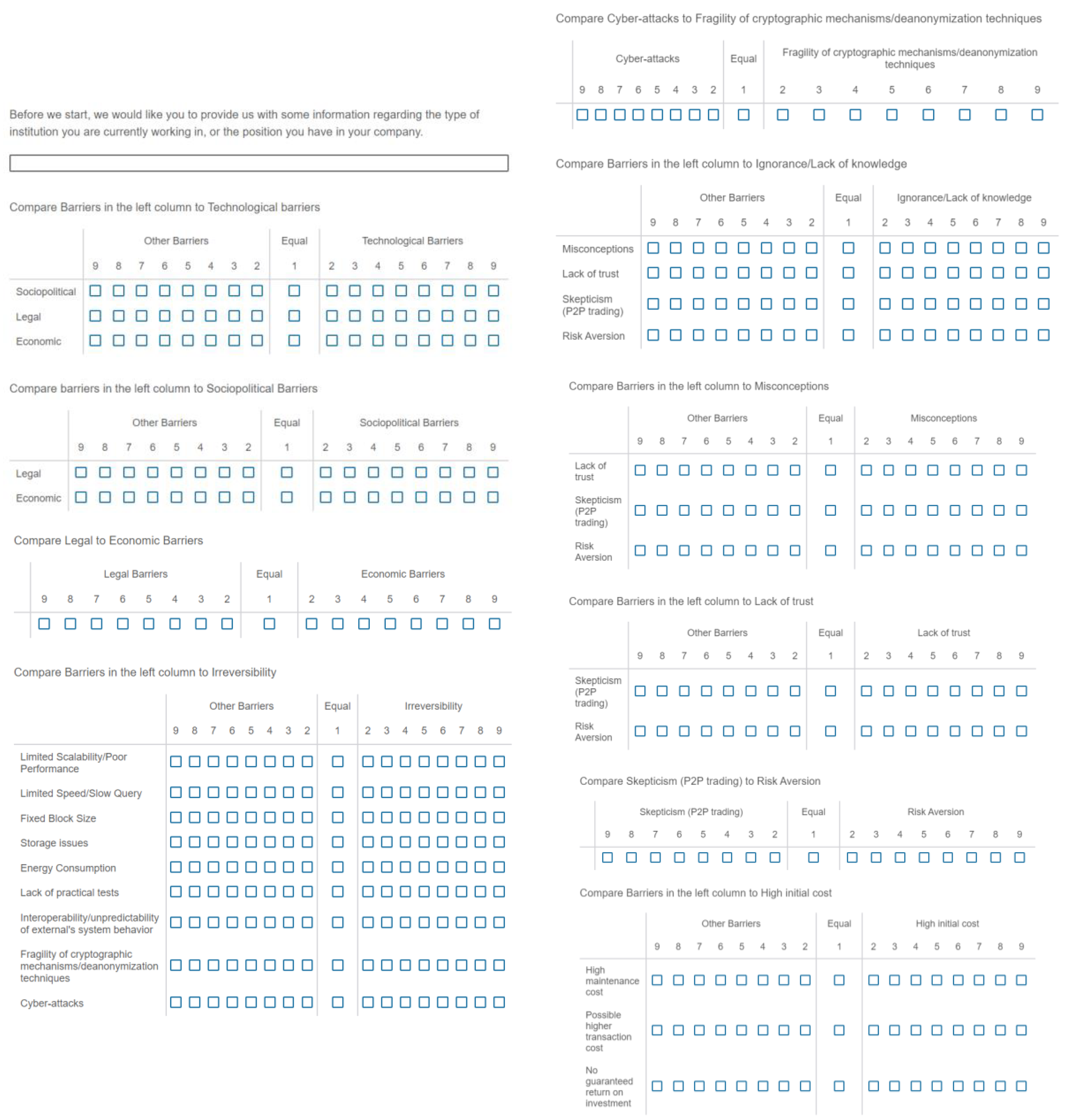

References
- Karakosta, C.; Papapostolou, A. Energy efficiency trends in the Greek building sector: A participatory approach. Euro-Mediterr. J. Environ. Integr. 2023, 8, 3–13. [Google Scholar] [CrossRef]
- Papapostolou, A.; Mexis, F.D.; Karakosta, C.; Psarras, J. A multicriteria tool to support decision-making in the early stages of energy efficiency investments. In Lecture Notes in Business Information Processing; 447 LNBIP; Springer International Publishing: Cham, Switzerland, 2022; pp. 190–202. [Google Scholar] [CrossRef]
- Mexis, F.D.; Papapostolou, A.; Karakosta, C.; Sarmas, E.; Koutsandreas, D.; Doukas, H. Leveraging energy efficiency investments: An innovative web-based benchmarking tool. Adv. Sci. Technol. Eng. Syst. J. 2021, 6, 237–248. [Google Scholar] [CrossRef]
- Karakosta, C.; Mylona, Z.; Karásek, J.; Papapostolou, A.; Geiseler, E. Tackling COVID-19 crisis through energy efficiency investments: Decision support tools for economic recovery. Energy Strategy Rev. 2021, 38, 100764. [Google Scholar] [CrossRef]
- Papapostolou, A.; Mexis, F.D.; Sarmas, E.; Karakosta, C.; Psarras, J. Web-based Application for Screening Energy Efficiency Investments: A MCDA Approach. In Proceedings of the 11th International Conference on Information, Intelligence, Systems and Applications (IISA), Piraeus, Greece, 15–17 July 2020; pp. 1–7. [Google Scholar] [CrossRef]
- Mexis, F.D.; Papapostolou, A.; Karakosta, C.; Psarras, J. Financing Sustainable Energy Efficiency Projects: The Triple-A Case. Environ. Sci. Proc. 2021, 11, 22. [Google Scholar] [CrossRef]
- Papapostolou, A.; Andreoulaki, I.; Divolis, S.; Anagnostopoulos, F.; Marinakis, V. Distributed Ledger Technology in Energy Services: The InEExS Project Objectives and Approach. In Proceedings of the 14th International Conference on Information, Intelligence, Systems & Applications (IISA), Volos, Greece, 10–12 July, 2023; IEEE: Piscataway, NJ, USA, 2023; pp. 1–9. [Google Scholar] [CrossRef]
- Nakamoto, S. Bitcoin: A peer-to-peer electronic cash system. Decentralized Bus. Rev. 2008. [Google Scholar]
- Prakash, R.; Anoop, V.S.; Asharaf, S. Blockchain technology for cybersecurity: A text mining literature analysis. Int. J. Inf. Manag. Data Insights 2022, 2, 100112. [Google Scholar] [CrossRef]
- Guo, H.; Yu, X. A Survey on Blockchain Technology and its security. Blockchain Res. Appl. 2022, 3, 100067. [Google Scholar] [CrossRef]
- Khan, S.N.; Loukil, F.; Ghedira-Guegan, C.; Benkhelifa, E.; Bani-Hani, A. Blockchain smart contracts: Applications, challenges, and future trends. Peer-Peer Netw. Appl. 2021, 14, 2901–2925. [Google Scholar] [CrossRef]
- Gaetani, E.; Aniello, L.; Baldoni, R.; Lombardi, F.; Margheri, A.; Sassone, V. Blockchain-based database to ensure data integrity in cloud computing environments. In Proceedings of the Italian Conference on Cybersecurity, Venice, Italy, 17–20 January 2017. [Google Scholar]
- Merlo, V.; Pio, G.; Giusto, F.; Bilancia, M. On the exploitation of the blockchain technology in the healthcare sector: A systematic review. Expert Syst. Appl. 2022, 213, 118897. [Google Scholar] [CrossRef]
- Fraga-Lamas, P.; Fernández-Caramés, T.M. A review on blockchain technologies for an advanced and cyber-resilient automotive industry. IEEE Access 2019, 7, 17578–17598. [Google Scholar] [CrossRef]
- Babu, E.S.; SrinivasaRao, B.K.N.; Nayak, S.R.; Verma, A.; Alqahtani, F.; Tolba, A.; Mukherjee, A. Blockchain-based Intrusion Detection System of IoT urban data with device authentication against DDoS attacks. Comput. Electr. Eng. 2022, 103, 108287. [Google Scholar] [CrossRef]
- Wang, Y.; Han, J.H.; Beynon-Davies, P. Understanding blockchain technology for future supply chains: A systematic literature review and research agenda. Supply Chain Manag. Int. J. 2019, 24, 62–84. [Google Scholar] [CrossRef]
- van Groesen, W.; Pauwels, P. Tracking prefabricated assets and compliance using quick response (QR) codes, blockchain and smart contract technology. Autom. Constr. 2022, 141, 104420. [Google Scholar] [CrossRef]
- Liao, C.H.; Guan, X.Q.; Cheng, J.H.; Yuan, S.M. Blockchain-based identity management and access control framework for open banking ecosystem. Future Gener. Comput. Syst. 2022, 135, 450–466. [Google Scholar] [CrossRef]
- Peng, L.; Feng, W.; Yan, Z.; Li, Y.; Zhou, X.; Shimizu, S. Privacy preservation in permissionless blockchain: A survey. Digit. Commun. Netw. 2022, 7, 295–307. [Google Scholar] [CrossRef]
- Gupta, P.; Dedeoglu, V.; Kanhere, S.S.; Jurdak, R. TrailChain: Traceability of data ownership across blockchain-enabled multiple marketplaces. J. Netw. Comput. Appl. 2022, 203, 103389. [Google Scholar] [CrossRef]
- Almasoud, A.S.; Hussain, F.K.; Hussain, O.K. Smart contracts for blockchain-based reputation systems: A systematic literature review. J. Netw. Comput. Appl. 2020, 170, 102814. [Google Scholar] [CrossRef]
- Raimundo, R.; Rosário, A. Blockchain system in the higher education. Eur. J. Investig. Health Psychol. Educ. 2021, 11, 276–293. [Google Scholar] [CrossRef] [PubMed]
- Wang, N.; Xu, H.; Xu, F.; Cheng, L. The algorithmic composition for music copyright protection under deep learning and blockchain. Appl. Soft Comput. 2021, 112, 107763. [Google Scholar] [CrossRef]
- ScienceDirect.com|Science, Health and Medical Journals, Full Text Articles and Books. Available online: https://www.sciencedirect.com/ (accessed on 29 February 2024).
- ResearchGate|Find and Share Research. ResearchGate. Available online: https://www.researchgate.net/ (accessed on 29 February 2024).
- Scopus|Abstract and Citation Database. Elsevier. Available online: https://www.elsevier.com/products/scopus?dgcid=RN_AGCM_Sourced_300005030 (accessed on 29 February 2024).
- IEEE Xplore. Available online: https://ieeexplore.ieee.org/Xplore/home.jsp (accessed on 29 February 2024).
- Perera, R. The PESTLE Analysis; Nerdynaut: Avissawella, Sri Lanka, 2017. [Google Scholar]
- Zahari, A.R.; Romli, F.I. Analysis of suborbital flight operation using PESTLE. J. Atmos. Sol.-Terr. Phys. 2019, 192, 104901. [Google Scholar] [CrossRef]
- Gurl, E. SWOT analysis: A theoretical review. J. Int. Soc. Res. 2017, 4, 347–370. [Google Scholar] [CrossRef]
- Kangas, J.; Kurttila, M.; Kajanus, M.; Kangas, A. Evaluating the management strategies of a forestland estate—The SOS approach. J. Environ. Manag. 2003, 69, 349–358. [Google Scholar] [CrossRef] [PubMed]
- Ghazinoory, S.; Abdi, M.; Azadegan-Mehr, M. SWOT methodology: A state-of-the-art review for the past, a framework for the future. J. Bus. Econ. Manag. 2011, 12, 24–48. [Google Scholar] [CrossRef]
- Abbasi, S.A.; Harijan, K.; Memon, Z.A.; Shaikh, F.; Mirjat, N.H. Is coal power generation a sustainable solution for energy needs of Pakistan: A Delphi-SWOT paradigm? Int. J. Energy Econ. Policy 2021, 11, 308–317. [Google Scholar] [CrossRef]
- Almutairi, K.; Hosseini Dehshiri, S.J.; Hosseini Dehshiri, S.S.; Mostafaeipour, A.; Hoa, A.X.; Techato, K. Determination of optimal renewable energy growth strategies using SWOT analysis, hybrid MCDM methods, and game theory: A case study. Int. J. Energy Res. 2022, 46, 6766–6789. [Google Scholar] [CrossRef]
- Pohekar, S.D.; Ramachandran, M. Application of multi-criteria decision making to sustainable energy planning—A review. Renew. Sustain. Energy Rev. 2004, 8, 365–381. [Google Scholar] [CrossRef]
- Papapostolou, A.; Karakosta, C.; Apostolidis, G.; Doukas, H. An AHP-SWOT-Fuzzy TOPSIS approach for achieving a cross-border RES cooperation. Sustainability 2020, 12, 2886. [Google Scholar] [CrossRef]
- Akçaba, S.; Eminer, F. Evaluation of strategic energy alternatives determined for Northern Cyprus with SWOT based MCDM integrated approach. Energy Rep. 2022, 8, 11022–11038. [Google Scholar] [CrossRef]
- Ervural, B.C.; Zaim, S.; Demirel, O.F.; Aydin, Z.; Delen, D. An ANP and fuzzy TOPSIS-based SWOT analysis for Turkey’s energy planning. Renew. Sustain. Energy Rev. 2018, 82, 1538–1550. [Google Scholar] [CrossRef]
- Diakoulaki, D.; Antunes, C.H.; Gomes Martins, A. MCDA and energy planning. In Multiple Criteria Decision Analysis: State of the Art Surveys; Springer: Berlin/Heidelberg, Germany, 2005; pp. 859–890. [Google Scholar]
- Cinelli, M.; Coles, S.R.; Kirwan, K. Analysis of the potentials of multi criteria decision analysis methods to conduct sustainability assessment. Ecol. Indic. 2014, 46, 138–148. [Google Scholar] [CrossRef]
- Podgórski, D. Measuring operational performance of OSH management system–a demonstration of AHP-based selection of leading key performance indicators. Saf. Sci. 2015, 73, 146–166. [Google Scholar] [CrossRef]
- Sellitto, M.A.; Valladares, D.R.F.; Pastore, E.; Alfieri, A. Comparing competitive priorities of slow fashion and fast fashion operations of large retailers in an emerging economy. Glob. J. Flex. Syst. Manag. 2022, 23, 1–19. [Google Scholar] [CrossRef]
- Huang, L.; Zhen, L.; Wang, J.; Zhang, X. Blockchain implementation for circular supply chain management: Evaluating critical success factors. Ind. Mark. Manag. 2022, 102, 451–464. [Google Scholar] [CrossRef]
- Garrido, A.; Lopez, L.J.R.; Álvarez, N.B. A simulation-based AHP approach to analyze the scalability of EHR systems using blockchain technology in healthcare institutions. Inform. Med. Unlocked 2021, 24, 100576. [Google Scholar] [CrossRef]
- Li, D.; Gong, Y. The design of power grid data management system based on blockchain technology and construction of system security evaluation model. Energy Rep. 2022, 8, 466–479. [Google Scholar] [CrossRef]
- Ar, I.M.; Erol, I.; Peker, I.; Ozdemir, A.I.; Medeni, T.D.; Medeni, I.T. Evaluating the feasibility of blockchain in logistics operations: A decision framework. Expert Syst. Appl. 2020, 158, 113543. [Google Scholar] [CrossRef]
- Khezami, N.; Gharbi, N.; Neji, B.; Braiek, N.B. Blockchain Technology Implementation in the Energy Sector: Comprehensive Literature Review and Mapping. Sustainability 2022, 14, 15826. [Google Scholar] [CrossRef]
- Wang, Q.; Su, M. Integrating blockchain technology into the energy sector—From theory of blockchain to research and application of energy blockchain. Comput. Sci. Rev. 2020, 37, 100275. [Google Scholar] [CrossRef]
- Wu, J.; Tran, N.K. Application of blockchain technology in sustainable energy systems: An overview. Sustainability 2018, 10, 3067. [Google Scholar] [CrossRef]
- Cao, Y.N.; Wang, Y.; Ding, Y.; Guo, Z.; Wu, Q.; Liang, H. Blockchain-empowered security and privacy protection technologies for smart grid. Comput. Stand. Interfaces 2022, 85, 103708. [Google Scholar] [CrossRef]
- Ferrag, M.A.; Maglaras, L. DeepCoin: A novel deep learning and blockchain-based energy exchange framework for smart grids. IEEE Trans. Eng. Manag. 2019, 67, 1285–1297. [Google Scholar] [CrossRef]
- Stübs, M.; Posdorfer, W.; Kalinowski, J. Business-driven blockchain-mempool model for cooperative optimization in smart grids. In Smart Trends in Computing and Communications, Proceedings of SmartCom 2019; Springer: Singapore, 2019; pp. 31–39. [Google Scholar] [CrossRef]
- Swain, A.; Salkuti, S.R.; Swain, K. An optimized and decentralized energy provision system for smart cities. Energies 2021, 14, 1451. [Google Scholar] [CrossRef]
- Wang, L.; Jiao, S.; Xie, Y.; Mubaarak, S.; Zhang, D.; Liu, J.; Jiang, S.; Zhang, Y.; Li, M. A permissioned blockchain-based energy management system for renewable energy microgrids. Sustainability 2021, 13, 1317. [Google Scholar] [CrossRef]
- Wang, L.; Jiang, S.; Shi, Y.; Du, X.; Xiao, Y.; Ma, Y.; Yi, X.; Zhang, Y.; Li, M. Blockchain-based dynamic energy management mode for distributed energy system with high penetration of renewable energy. Int. J. Electr. Power Energy Syst. 2023, 148, 108933. [Google Scholar] [CrossRef]
- AlSkaif, T.; Van Leeuwen, G. Decentralized optimal power flow in distribution networks using blockchain. In Proceedings of the 2019 International Conference on Smart Energy Systems and Technologies (SEST), Porto, Portugal, 9–11 September 2019; IEEE: Piscataway, NJ, USA, 2019; pp. 1–6. [Google Scholar] [CrossRef]
- Liu, N.; Tan, L.; Zhou, L.; Chen, Q. Multi-party energy management of energy hub: A hybrid approach with Stackelberg game and blockchain. J. Mod. Power Syst. Clean Energy 2020, 8, 919–928. [Google Scholar] [CrossRef]
- Yang, Q.; Wang, H.; Wang, T.; Zhang, S.; Wu, X.; Wang, H. Blockchain based decentralized energy management platform for residential distributed energy resources in a virtual power plant. Appl. Energy 2021, 294, 117026. [Google Scholar] [CrossRef]
- Jia, C.; Ding, H.; Zhang, C.; Zhang, X. Design of a dynamic key management plan for intelligent building energy management system based on wireless sensor network and blockchain technology. Alex. Eng. J. 2021, 60, 337–346. [Google Scholar] [CrossRef]
- Van Cutsem, O.; Dac, D.H.; Boudou, P.; Kayal, M. Cooperative energy management of a community of smart buildings: A Blockchain approach. Int. J. Electr. Power Energy Syst. 2020, 117, 105643. [Google Scholar] [CrossRef]
- Noor, S.; Yang, W.; Guo, M.; van Dam, K.H.; Wang, X. Energy demand side management within micro-grid networks enhanced by blockchain. Appl. Energy 2018, 228, 1385–1398. [Google Scholar] [CrossRef]
- Ruan, H.; Gao, H.; Qiu, H.; Gooi, H.B.; Liu, J. Distributed operation optimization of active distribution network with P2P electricity trading in blockchain environment. Appl. Energy 2023, 331, 120405. [Google Scholar] [CrossRef]
- Wang, X.; Liu, Y.; Ma, R.; Su, Y.; Ma, T. Blockchain enabled smart community for bilateral energy transaction. Int. J. Electr. Power Energy Syst. 2023, 148, 108997. [Google Scholar] [CrossRef]
- Sabounchi, M.; Wei, J. Towards resilient networked microgrids: Blockchain-enabled peer-to-peer electricity trading mechanism. In Proceedings of the IEEE Conference on Energy Internet and Energy System Integration (EI2), Beijing, China, 26–28 November 2017; IEEE: Piscataway, NJ, USA, 2017; pp. 1–5. [Google Scholar] [CrossRef]
- Kostmann, M.; Härdle, W.K. Forecasting in blockchain-based local energy markets. Energies 2019, 12, 2718. [Google Scholar] [CrossRef]
- Wang, N.; Chau, S.C.K.; Zhou, Y. Privacy-Preserving Energy Storage Sharing with Blockchain. In Proceedings of the Twelfth ACM International Conference on Future Energy Systems, Torino, Italy, 28 June–2 July 2021; pp. 185–198. [Google Scholar] [CrossRef]
- Habbak, H.; Baza, M.; Mahmoud, M.M.; Metwally, K.; Mattar, A.; Salama, G.I. Privacy-Preserving Charging Coordination Scheme for Smart Power Grids Using a Blockchain. Energies 2022, 15, 8996. [Google Scholar] [CrossRef]
- Li, P.; Ou, W.; Liang, H.; Han, W.; Zhang, Q.; Zeng, G. A zero trust and blockchain-based defense model for smart electric vehicle chargers. J. Netw. Comput. Appl. 2023, 213, 103599. [Google Scholar] [CrossRef]
- Huang, X.; Zhang, Y.; Li, D.; Han, L. An optimal scheduling algorithm for hybrid EV charging scenario using consortium blockchains. Future Gener. Comput. Syst. 2019, 91, 555–562. [Google Scholar] [CrossRef]
- Khan, P.W.; Byun, Y.C. Blockchain-based peer-to-peer energy trading and charging payment system for electric vehicles. Sustainability 2021, 13, 7962. [Google Scholar] [CrossRef]
- Kang, J.; Yu, R.; Huang, X.; Maharjan, S.; Zhang, Y.; Hossain, E. Enabling localized peer-to-peer electricity trading among plug-in hybrid electric vehicles using consortium blockchains. IEEE Trans. Ind. Inform. 2017, 13, 3154–3164. [Google Scholar] [CrossRef]
- Augello, A.; Gallo, P.; Sanseverino, E.R.; Sciabica, G.; Sciumè, G. Certifying battery usage for V2G and second life with a blockchain-based framework. Comput. Netw. 2023, 222, 109558. [Google Scholar] [CrossRef]
- Gupta, D.S.; Karati, A.; Saad, W.; da Costa, D.B. Quantum-defended blockchain-assisted data authentication protocol for internet of vehicles. IEEE Trans. Veh. Technol. 2022, 71, 3255–3266. [Google Scholar] [CrossRef]
- Fu, Y.; Yu, F.R.; Li, C.; Luan, T.H.; Zhang, Y. Vehicular blockchain-based collective learning for connected and autonomous vehicles. IEEE Wirel. Commun. 2020, 27, 197–203. [Google Scholar] [CrossRef]
- Zhang, T.Y.; Feng, T.T.; Cui, M.L. Smart contract design and process optimization of carbon trading based on blockchain: The case of China’s electric power sector. J. Clean. Prod. 2023, 397, 136509. [Google Scholar] [CrossRef]
- Effah, D.; Chunguang, B.; Appiah, F.; Agbley, B.L.Y.; Quayson, M. Carbon emission monitoring and credit trading: The blockchain and IOT approach. In Proceedings of the 2021 18th International Computer Conference on Wavelet Active Media Technology and Information Processing (ICCWAMTIP), Chengdu, China, 17–19 December 2021; IEEE: Piscataway, NJ, USA, 2021; pp. 106–109. [Google Scholar] [CrossRef]
- Khaqqi, K.N.; Sikorski, J.J.; Hadinoto, K.; Kraft, M. Incorporating seller/buyer reputation-based system in blockchain-enabled emission trading application. Appl. Energy 2018, 209, 8–19. [Google Scholar] [CrossRef]
- Zhong, X.; Liu, Y.; Xie, K.; Xie, S. A Local Electricity and Carbon Trading Method for Multi-Energy Microgrids Considering Cross-Chain Interaction. Sensors 2022, 22, 6935. [Google Scholar] [CrossRef]
- Delardas, O.; Giannos, P. Towards Energy Transition: Use of Blockchain in Renewable Certificates to Support Sustainability Commitments. Sustainability 2022, 15, 258. [Google Scholar] [CrossRef]
- Ashley, M.J.; Johnson, M.S. Establishing a secure, transparent, and autonomous blockchain of custody for renewable energy credits and carbon credits. IEEE Eng. Manag. Rev. 2018, 46, 100–102. [Google Scholar] [CrossRef]
- Olivares-Rojas, J.C.; Reyes-Archundia, E.; Gutiérrez-Gnecchi, J.A.; Cerda-Jacobo, J.; González-Murueta, J.W. A novel multitier blockchain architecture to protect data in smart metering systems. IEEE Trans. Eng. Manag. 2019, 67, 1271–1284. [Google Scholar] [CrossRef]
- Wang, H.; Wu, B. Design of wind farm information system based on blockchain technology. In IOP Conference Series: Earth and Environmental Science; IOP Publishing: Bristol, UK, 2021; Volume 647, p. 012006. [Google Scholar]
- Kwak, S.; Lee, J.; Kim, J.; Oh, H. EggBlock: Design and Implementation of Solar Energy Generation and Trading Platform in Edge-Based IoT Systems with Blockchain. Sensors 2022, 22, 2410. [Google Scholar] [CrossRef]
- Gao, G.; Song, C.; Bandara, T.T.A.; Shen, M.; Yang, F.; Posdorfer, W.; Wen, Y. FogChain: A blockchain-based peer-to-peer solar power trading system powered by fog AI. IEEE Internet Things J. 2021, 9, 5200–5215. [Google Scholar] [CrossRef]
- EUBlockchain|Blockchain Applications in the Energy Sector. EUBlockchain. Available online: https://www.eublockchainforum.eu/reports/blockchain-applications-energy-sector (accessed on 17 January 2024).
- Home|INTERRFACE. Available online: http://www.interrface.eu/ (accessed on 17 January 2024).
- Home|BD4NRG. Available online: https://www.bd4nrg.eu/ (accessed on 17 January 2024).
- Bright Project. Available online: https://www.brightproject.eu/ (accessed on 17 January 2024).
- Dedalus Horizon—Homepage. Available online: https://dedalus-horizon.eu/ (accessed on 17 January 2024).
- Platone—Welcome to Platone—Platform for Operation of Distribution Networks. Available online: https://www.platone-h2020.eu/ (accessed on 17 January 2024).
- HOME|Flexunity. Available online: https://www.flexunity.eu/ (accessed on 17 January 2024).
- Parity H2020. Available online: https://parity-h2020.eu/ (accessed on 17 January 2024).
- EU-Startups. WePower. 16 April 2020. Available online: https://www.eu-startups.com/directory/wepower/ (accessed on 17 January 2024).
- The Sun Exchange. Earn with Purpose|The Sun Exchange. The Sun Exchange. Available online: https://thesunexchange.com/ (accessed on 17 January 2024).
- The Institute for European Energy and Climate Policy (IEECP). INEEXS—IEECP. IEECP. Available online: https://ieecp.org/projects/ineexs/ (accessed on 16 January 2024).
- Papapostolou, A.; Divolis, S.; Marinakis, V. Identifying barriers hindering the application of blockchain in the energy sector: Pestle and SWOT analyses. In Proceedings: International Scientific Conference EMAN Economics & Management: How to Cope with Disrupted Times; Association of Economists and Managers of the Balkans—UdEkoM Balkan: Belgrade, Serbia, 2023; ISSN 2683-4510. [Google Scholar]
- Bürer, M.J.; de Lapparent, M.; Pallotta, V.; Capezzali, M.; Carpita, M. Use cases for blockchain in the energy industry opportunities of emerging business models and related risks. Comput. Ind. Eng. 2019, 137, 106002. [Google Scholar] [CrossRef]
- Diestelmeier, L. Changing power: Shifting the role of electricity consumers with blockchain technology–Policy implications for EU electricity law. Energy Policy 2019, 128, 189–196. [Google Scholar] [CrossRef]
- Juszczyk, O.; Shahzad, K. Blockchain technology for renewable energy: Principles, applications and prospects. Energies 2022, 15, 4603. [Google Scholar] [CrossRef]
- Teufel, B.; Sentic, A.; Barmet, M. Blockchain energy: Blockchain in future energy systems. J. Electron. Sci. Technol. 2019, 17, 100011. [Google Scholar] [CrossRef]
- Sadhya, V.; Sadhya, H. Barriers to Adoption of Blockchain Technology. 2018. Available online: https://aisel.aisnet.org/amcis2018/AdoptionDiff/Presentations/20/ (accessed on 15 January 2024).
- Morstyn, T.; Farrell, N.; Darby, S.J.; McCulloch, M.D. Using peer-to-peer energy-trading platforms to incentivize prosumers to form federated power plants. Nat. Energy 2018, 3, 94–101. [Google Scholar] [CrossRef]
- Ahl, A.; Goto, M.; Yarime, M.; Tanaka, K.; Sagawa, D. Challenges and opportunities of blockchain energy applications: Interrelatedness among technological, economic, social, environmental, and institutional dimensions. Renew. Sustain. Energy Rev. 2022, 166, 112623. [Google Scholar] [CrossRef]
- Egelund-Müller, B.; Elsman, M.; Henglein, F.; Ross, O. Automated execution of financial contracts on blockchains. Bus. Inf. Syst. Eng. 2017, 59, 457–467. [Google Scholar] [CrossRef]
- Erturk, E.; Lopez, D.; Yu, W.Y. Benefits and risks of using blockchain in smart energy: A literature review. Contemp. Manag. Res. 2019, 15, 205–225. [Google Scholar] [CrossRef]
- Borges, C.E.; Kapassa, E.; Touloupou, M.; Legarda Macón, J.; Casado-Mansilla, D. Blockchain application in P2P energy markets: Social and legal aspects. Connect. Sci. 2022, 34, 1066–1088. [Google Scholar] [CrossRef]
- Danzi, P.; Angjelichinoski, M.; Stefanović, Č.; Popovski, P. Distributed proportional-fairness control in microgrids via blockchain smart contracts. In Proceedings of the 2017 IEEE International Conference on Smart Grid Communications (SmartGridComm), Dresden, Germany, 23–27 October 2017; IEEE: Piscataway, NJ, USA, 2017; pp. 45–51. [Google Scholar] [CrossRef]
- Lundqvist, T.; De Blanche, A.; Andersson, H.R.H. Thing-to-thing electricity micro payments using blockchain technology. In Proceedings of the Global Internet of Things Summit (GIoTS), Geneva, Switzerland, 6–9 June 2017; IEEE: Piscataway, NJ, USA, 2017; pp. 1–6. [Google Scholar] [CrossRef]
- Ingram, C.; Morisse, M.; Teigland, R. ‘A Bad Apple Went Away’: Exploring Resilience among Bitcoin Entrepreneurs. In Proceedings of the Twenty-Third European Conference on Information Systems (ECIS), Münster, Germany, 26–29 May 2015. [Google Scholar]
- Zhou, J.; Wu, Y.; Liu, F.; Tao, Y.; Gao, J. Prospects and obstacles analysis of applying blockchain technology to power trading using a deeply improved model based on the DEMATEL approach. Sustain. Cities Soc. 2021, 70, 102910. [Google Scholar] [CrossRef]
- Khalifa, A.M.; Bahaa-Eldin, A.M.; Sobh, M.A. Quantum attacks and defenses for proof-of-stake. In Proceedings of the 2019 14th International Conference on Computer Engineering and Systems (ICCES), Cairo, Egypt, 17 December 2019; IEEE: Piscataway, NJ, USA, 2019; pp. 112–117. [Google Scholar] [CrossRef]
- Fabian, B.; Ermakova, T.; Sander, U. Anonymity in Bitcoin?–the Users’ Perspective. 2016. Available online: https://www.researchgate.net/publication/308648091_Anonymity_in_Bitcoin_-_The_Users’_Perspective (accessed on 4 March 2024).
- Wang, T.; Hua, H.; Wei, Z.; Cao, J. Challenges of blockchain in new generation energy systems and future outlooks. Int. J. Electr. Power Energy Syst. 2022, 135, 107499. [Google Scholar] [CrossRef]
- Pop, C.; Antal, M.; Cioara, T.; Anghel, I.; Sera, D.; Salomie, I.; Raveduto, G.; Ziu, D.; Croce, V.; Bertoncini, M. Blockchain-based scalable and tamper-evident solution for registering energy data. Sensors 2019, 19, 3033. [Google Scholar] [CrossRef] [PubMed]
- Xinyi, Y.; Yi, Z.; He, Y. Technical characteristics and model of blockchain. In Proceedings of the 2018 10th International Conference on Communication Software and Networks (ICCSN), Chengdu, China, 6–9 July 2018; IEEE: Piscataway, NJ, USA, 2018; pp. 562–566. [Google Scholar] [CrossRef]
- Zheng, Z.; Xie, S.; Dai, H.N.; Chen, X.; Wang, H. Blockchain challenges and opportunities: A survey. Int. J. Web Grid Serv. 2018, 14, 352–375. [Google Scholar] [CrossRef]
- Monrat, A.A.; Schelén, O.; Andersson, K. A survey of blockchain from the perspectives of applications, challenges, and opportunities. IEEE Access 2019, 7, 117134–117151. [Google Scholar] [CrossRef]
- Chiarini, A.; Compagnucci, L. Blockchain, Data Protection and P2P Energy Trading: A Review on Legal and Economic Challenges. Sustainability 2022, 14, 16305. [Google Scholar] [CrossRef]
- Brilliantova, V.; Thurner, T.W. Blockchain and the future of energy. Technol. Soc. 2019, 57, 38–45. [Google Scholar] [CrossRef]
- Papapostolou, A.; Karakosta, C.; Kourti, K.A.; Doukas, H.; Psarras, J. Supporting Europe’s energy policy towards a decarbonised energy system: A comparative assessment. Sustainability 2019, 11, 4010. [Google Scholar] [CrossRef]
- Karakosta, C.; Papapostolou, A. Transformation Pathways Towards a Clean, Secure and Efficient European Energy System: A MCDA Approach. In A Comprehensive Guide to Energy Production and Development; Nova Science Publishers: Hauppauge, NY, USA, 2019. [Google Scholar]
- Papapostolou, A.; Karakosta, C.; Nikas, A.; Psarras, J. Exploring opportunities and risks for RES-E deployment under Cooperation Mechanisms between EU and Western Balkans: A multi-criteria assessment. Renew. Sustain. Energy Rev. 2017, 80, 519–530. [Google Scholar] [CrossRef]
- Papadogeorgos, I.; Papapostolou, A.; Karakosta, C.; Doukas, H. Multicriteria assessment of alternative policy scenarios for achieving EU RES target by 2030. In Strategic Innovative Marketing, Proceedings of the 5th IC-SIM, Athens, Greece 2016; Springer International Publishing: Cham, Switzerland, 2016; pp. 405–412. [Google Scholar] [CrossRef]
- Papapostolou, A.; Karakosta, C.; Doukas, H. Analysis of policy scenarios for achieving renewable energy sources targets: A fuzzy TOPSIS approach. Energy Environ. 2017, 28, 88–109. [Google Scholar] [CrossRef]
- Papapostolou, A.; Karakosta, C.; Marinakis, V.; Flamos, A. Assessment of RES cooperation framework between the EU and North Africa: A multicriteria approach based on UTASTAR. Int. J. Energy Sect. Manag. 2016, 10, 402–426. [Google Scholar] [CrossRef]
- Saaty, T. The Analytic Hierarchy Process (AHP) for Decision Making; McGraw-Hill: New York, NY, USA, 1980; Volume 1, p. 69. [Google Scholar]
- Lai, V.S.; Wong, B.K.; Cheung, W. Group decision making in a multiple criteria environment: A case using the AHP in software selection. Eur. J. Oper. Res. 2002, 137, 134–144. [Google Scholar] [CrossRef]
- Crawford, G.; Williams, C. A note on the analysis of subjective judgment matrices. J. Math. Psychol. 1985, 29, 387–405. [Google Scholar] [CrossRef]
- Aguarón, J.; Moreno-Jiménez, J.M. The geometric consistency index: Approximated thresholds. Eur. J. Oper. Res. 2003, 147, 137–145. [Google Scholar] [CrossRef]
- Forman, E.; Peniwati, K. Aggregating individual judgments and priorities with the analytic hierarchy process. Eur. J. Oper. Res. 1998, 108, 165–169. [Google Scholar] [CrossRef]
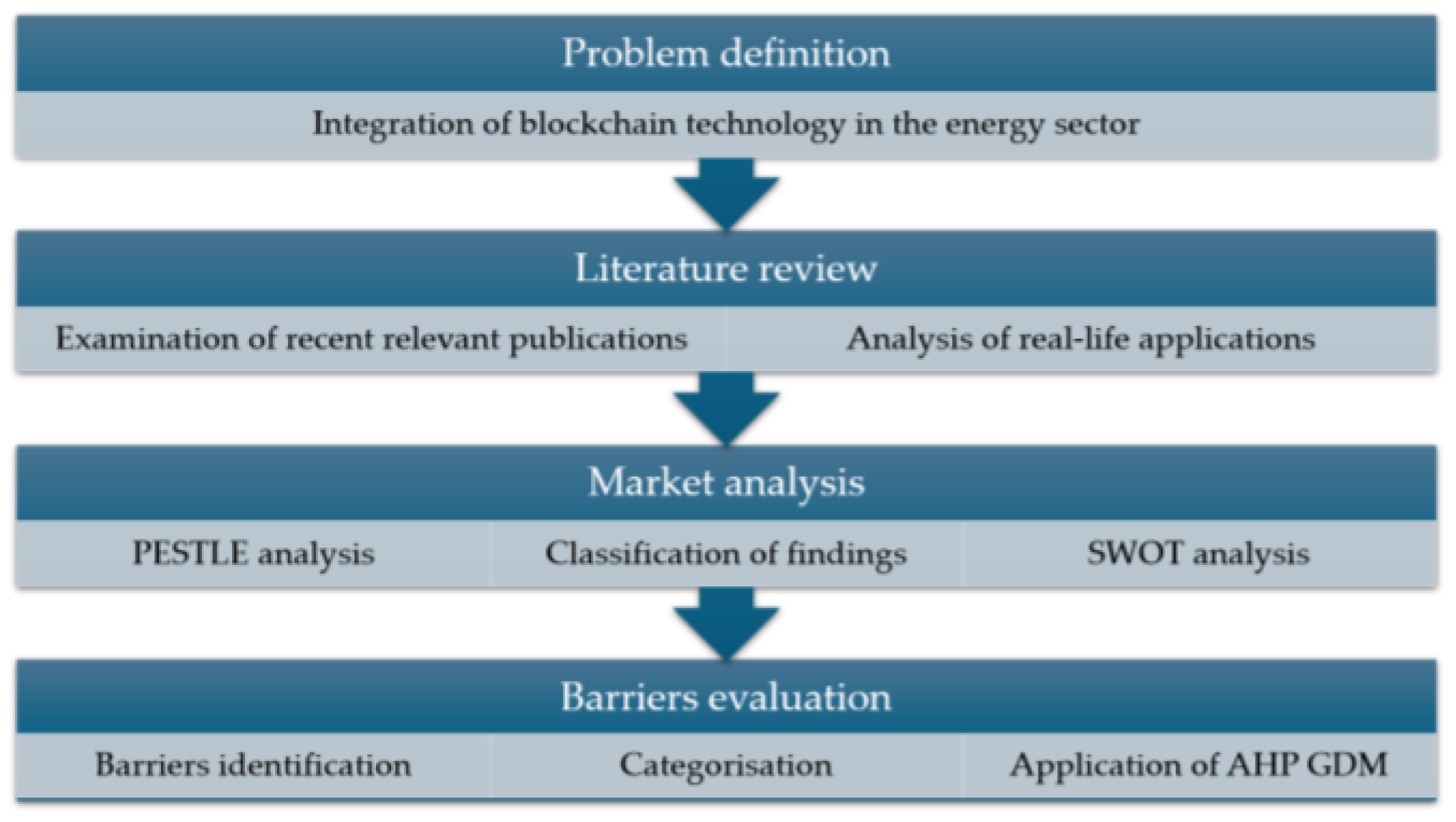

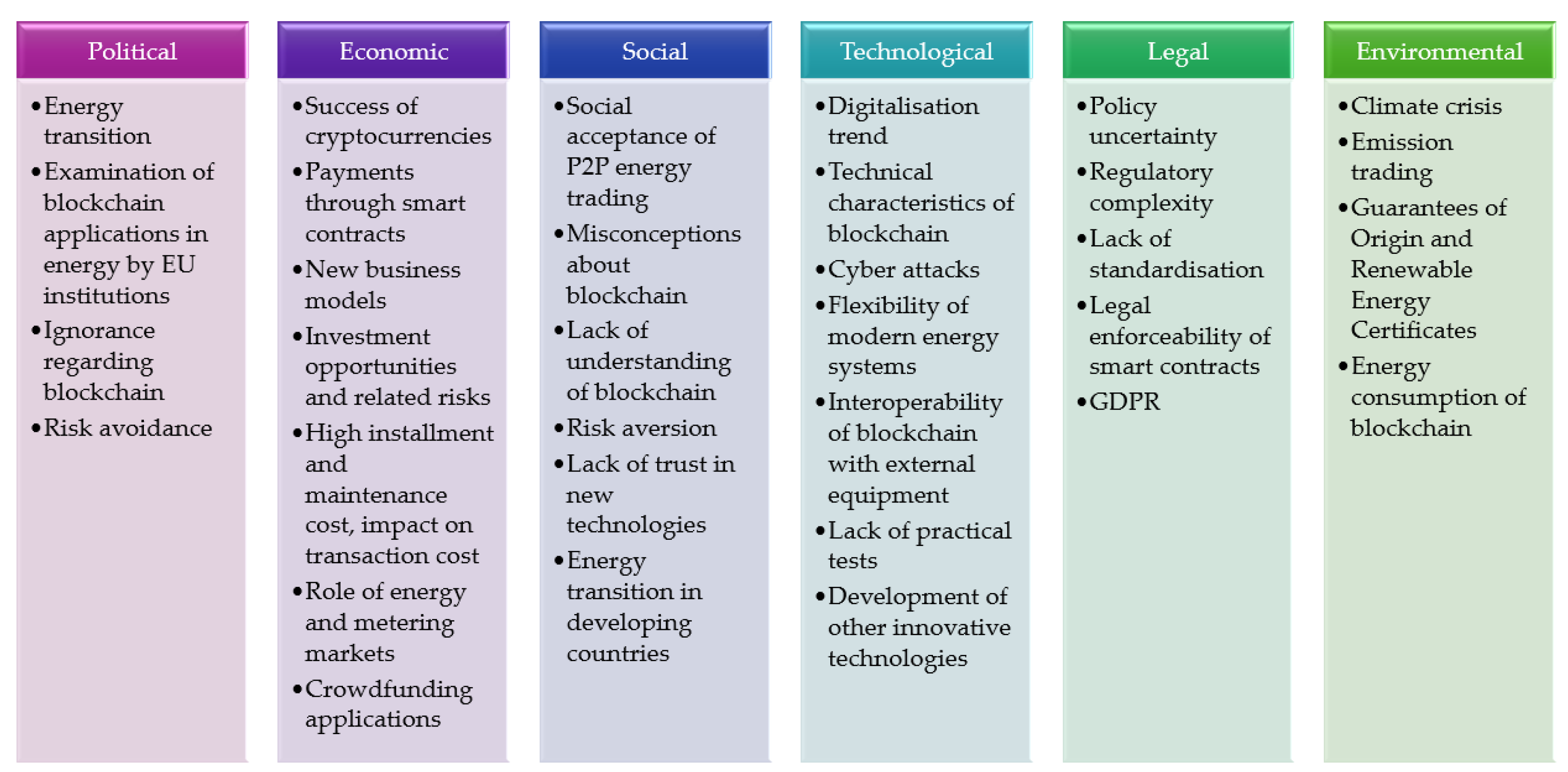
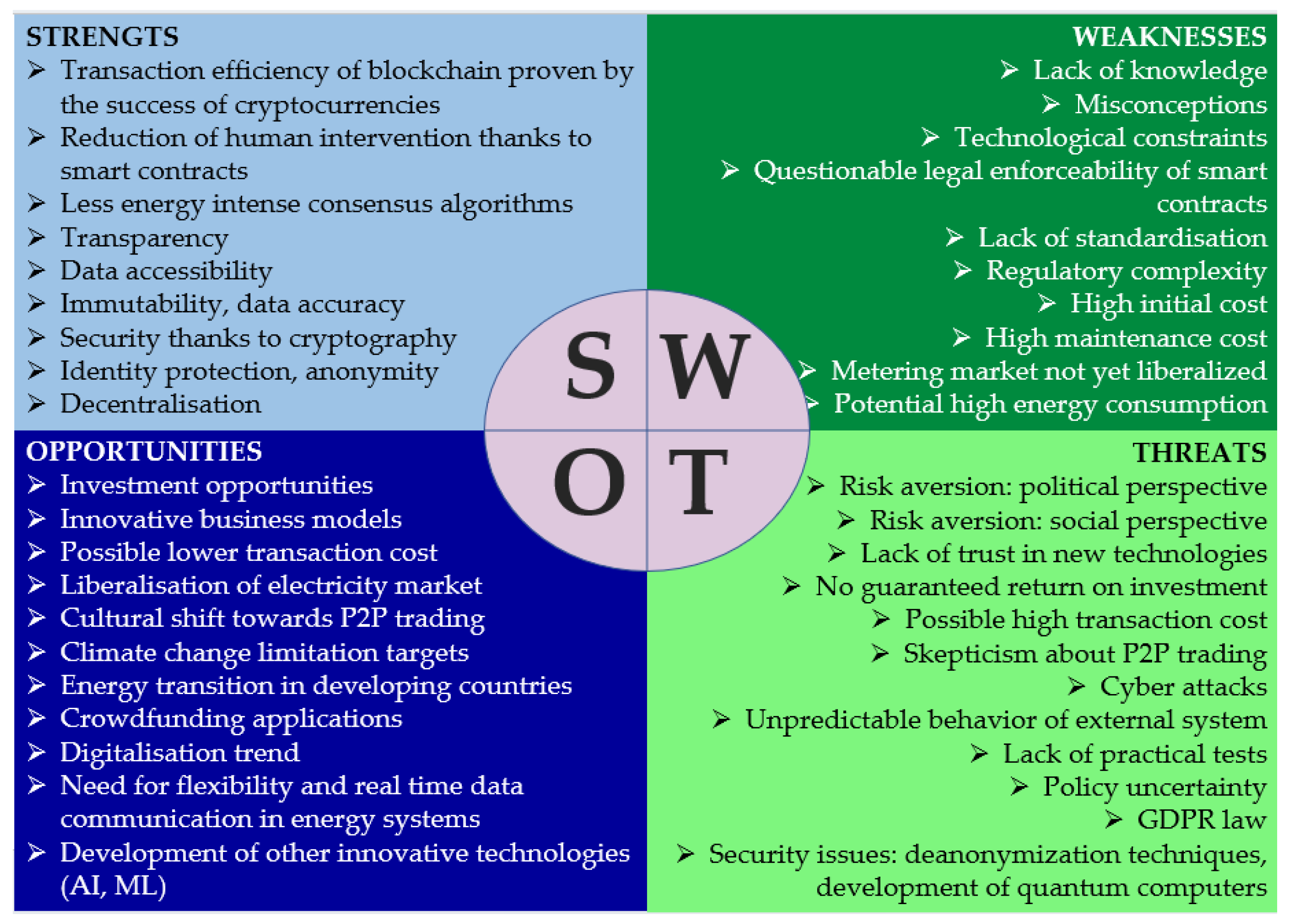
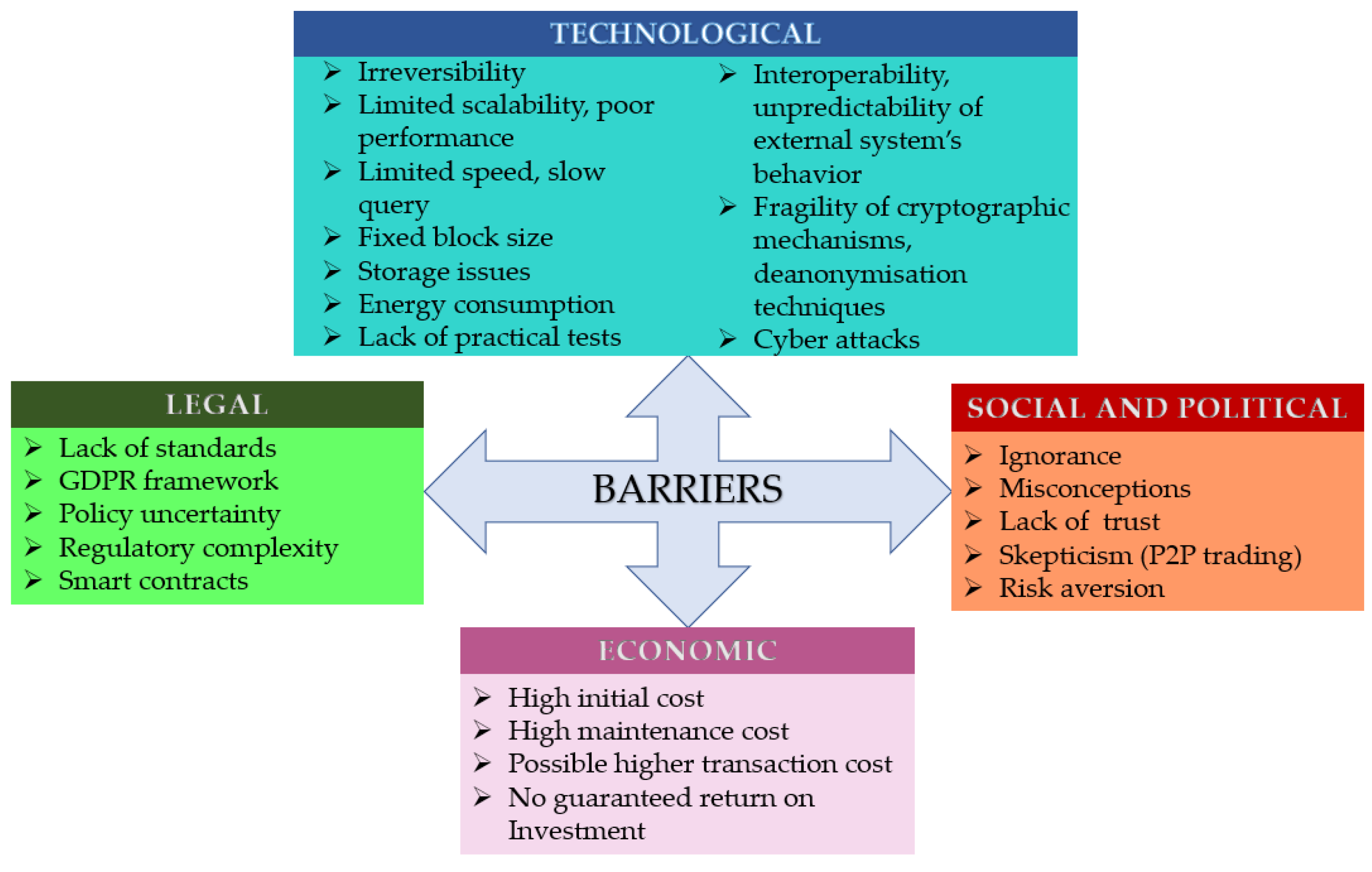

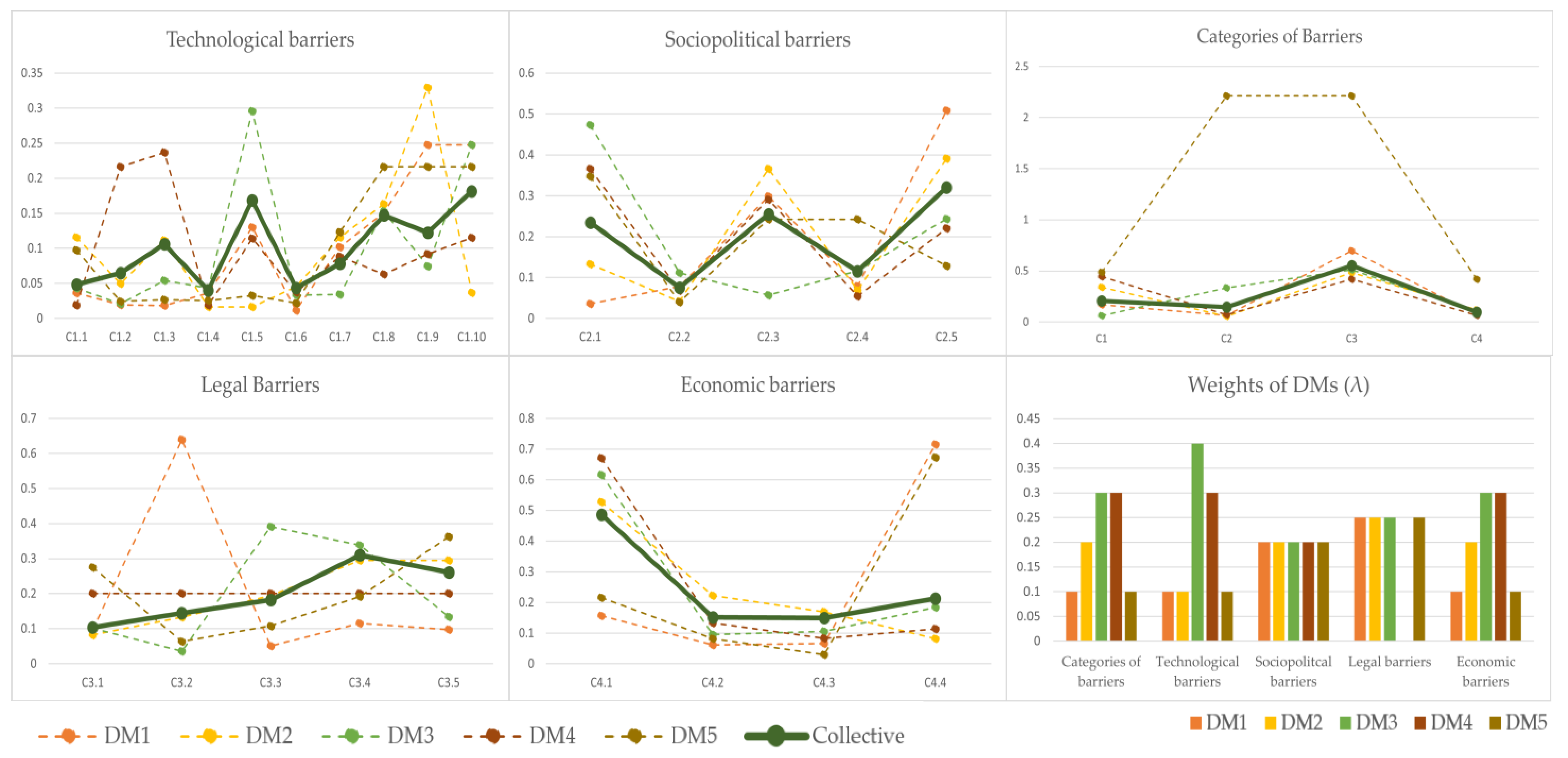
| Project | Description | Source |
|---|---|---|
| INTERFACE | A blockchain flexibility trading platform where TSOs, DSOs, FSPs and prosumers can safely transact without any central governing authority. | [86] |
| BD4NRG | Innovative data governance layer compliant with the International Data Space Association and P2P digital marketplace for heterogeneous tokenised asset compensation. | [87] |
| BRIGHT | Blockchain technologies supporting new community-enabled ways for engaging consumers in demand response. | [88] |
| DEDALUS | Blockchain-based solutions to preserve privacy, ensure trusted data governance and sovereignty, enable energy flexibility and data sharing with the aim of deploying effective algorithms and services for residential demand response. | [89] |
| PLATONE | Blockchain-based P2P trading, data management, data sharing, data certification, grid control, and economic transaction. | [90] |
| FleXunity | Energy community approach encouraging active involvement of community participants through flexibility and energy sharing supported by secure transaction mechanisms via blockchains. | [91] |
| PARITY | Local electricity market facilitating automated P2P energy/flexibility trading among prosumers and implicitly integrates a local flexibility market for facilitating the selling of flexibility to smart grid actors. | [92] |
| WePower | Platform directly connecting energy producers with end clients, allowing energy trading with pricing below the market’s threshold. | [93] |
| Sun Exchange | Crowdfunding platform for investments in small or medium-sized solar energy projects in developing countries. | [94] |
| InEExS | Smart energy services–business models facilitating the deployment of sustainable technologies (renewables, electric vehicles, heat pumps, Internet of Things, controls, and energy efficiency measures) via blockchains. | [95] |
| DMs | Brief Profile Description |
|---|---|
| 1 | Research and development (R&D) project manager in energy utility |
| 2 | General manager in energy consulting company |
| 3 | Research scientist on blockchain technology |
| 4 | Head of blockchain research |
| 5 | Member of research institute |
| Scale | Relative Importance |
|---|---|
| 1 | Equal importance |
| 3 | Moderate importance of one over the other |
| 5 | Strong or essential importance |
| 7 | Very strong or demonstrated importance |
| 9 | Extreme importance |
| 2, 4, 6, 8 | Intermediate values |
| Identifier | Ranking | Criterion | Collective Priority Vector |
|---|---|---|---|
| C3 | 1 | Legal Barriers | 0.550993 |
| C3.4 | 1.1 | Regulatory complexity | 0.310113 |
| C3.5 | 1.2 | Smart contracts | 0.26008 |
| C3.3 | 1.3 | Policy uncertainty | 0.181751 |
| C3.2 | 1.4 | GDPR | 0.14428 |
| C3.1 | 1.5 | Lack of standardisation | 0.103776 |
| C1 | 2 | Technological barriers | 0.206181 |
| C1.10 | 2.1 | Cyberattacks | 0.1813 |
| C1.5 | 2.2 | Storage issues | 0.1683 |
| C1.8 | 2.3 | Interoperability/unpredictability of external’s system behaviour | 0.1473 |
| C1.9 | 2.4 | Fragility of cryptographic mechanisms/deanonymisation techniques | 0.1222 |
| C1.3 | 2.5 | Limited speed/slow query | 0.1059 |
| C1.7 | 2.6 | Lack of practical tests | 0.078 |
| C1.2 | 2.7 | Limited scalability/poor performance | 0.0648 |
| C1.1 | 2.8 | Irreversibility | 0.0486 |
| C1.6 | 2.9 | Energy consumption | 0.0436 |
| C1.4 | 2.10 | Fixed block size | 0.04 |
| C2 | 3 | Sociopolitical barriers | 0.145392 |
| C2.5 | 3.1 | Risk avoidance | 0.320129 |
| C2.3 | 3.2 | Lack of trust | 0.25503 |
| C2.1 | 3.3 | Ignorance | 0.233954 |
| C2.4 | 3.4 | Skepticism (P2P trading) | 0.115632 |
| C2.2 | 3.5 | Misconceptions | 0.075256 |
| C4 | 4 | Economic barriers | 0.097434 |
| C4.1 | 4.1 | High initial cost | 0.486058 |
| C4.4 | 4.2 | No guaranteed return on investment | 0.212696 |
| C4.2 | 4.3 | High maintenance cost | 0.151625 |
| C4.3 | 4.4 | Possible higher transaction cost | 0.149622 |
Disclaimer/Publisher’s Note: The statements, opinions and data contained in all publications are solely those of the individual author(s) and contributor(s) and not of MDPI and/or the editor(s). MDPI and/or the editor(s) disclaim responsibility for any injury to people or property resulting from any ideas, methods, instructions or products referred to in the content. |
© 2024 by the authors. Licensee MDPI, Basel, Switzerland. This article is an open access article distributed under the terms and conditions of the Creative Commons Attribution (CC BY) license (https://creativecommons.org/licenses/by/4.0/).
Share and Cite
Andreoulaki, I.; Papapostolou, A.; Marinakis, V. Evaluating the Barriers to Blockchain Adoption in the Energy Sector: A Multicriteria Approach Using the Analytical Hierarchy Process for Group Decision Making. Energies 2024, 17, 1278. https://doi.org/10.3390/en17061278
Andreoulaki I, Papapostolou A, Marinakis V. Evaluating the Barriers to Blockchain Adoption in the Energy Sector: A Multicriteria Approach Using the Analytical Hierarchy Process for Group Decision Making. Energies. 2024; 17(6):1278. https://doi.org/10.3390/en17061278
Chicago/Turabian StyleAndreoulaki, Ioanna, Aikaterini Papapostolou, and Vangelis Marinakis. 2024. "Evaluating the Barriers to Blockchain Adoption in the Energy Sector: A Multicriteria Approach Using the Analytical Hierarchy Process for Group Decision Making" Energies 17, no. 6: 1278. https://doi.org/10.3390/en17061278
APA StyleAndreoulaki, I., Papapostolou, A., & Marinakis, V. (2024). Evaluating the Barriers to Blockchain Adoption in the Energy Sector: A Multicriteria Approach Using the Analytical Hierarchy Process for Group Decision Making. Energies, 17(6), 1278. https://doi.org/10.3390/en17061278








